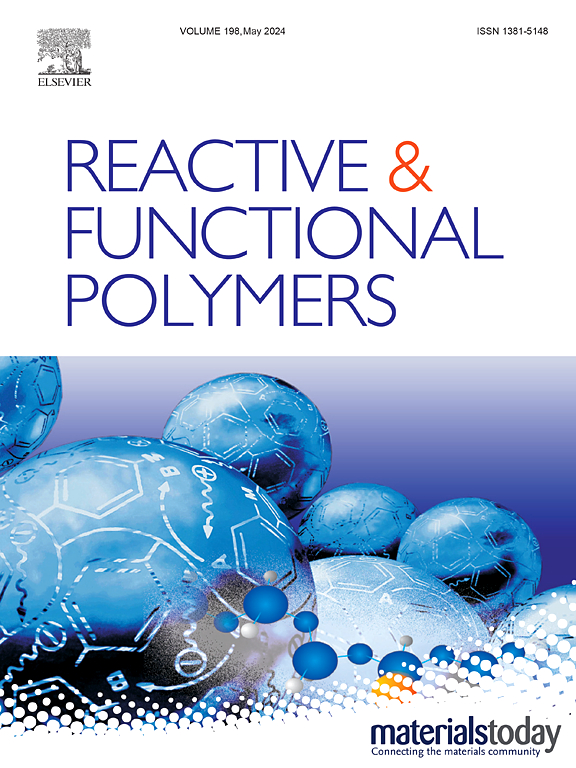Graphene oxide incorporated sodium alginate-gelatin composite hydrogel loaded with Moringa oleifera leaf extract for bifunctional tissue regeneration and anticancer applications
IF 5.1
3区 工程技术
Q1 CHEMISTRY, APPLIED
引用次数: 0
Abstract
This study presents the development of sodium alginate–gelatin (SG) composite hydrogel scaffolds incorporated with graphene oxide (GO) and loaded with Moringa oleifera leaf extract (MLE) for tissue regeneration and anticancer applications. The MLE was loaded in varying concentration 2.5 g/100 mL, 5 g/100 mL and 10 g/100 mL to SGG hydrogels (SGG@I, SGG@II and SGG@III) respectively. The prepared GO, SGG, SGG@I, SGG@II and SGG@III were characterized by X-ray diffraction (XRD), UV visible spectroscopy and Fourier Transform Infrared (FTIR) spectroscopy to evaluate the physiochemical properties. The swelling and degradation behavior of developed hydrogels were analyzed which stimulated under acidic pH 5.0 conditions. Also, The cumulative MLE release % from SGG@I, SGG@II and SGG@III hydrogels was observed to be enhanced under acidic pH 5.0 PBS medium. Mechanical testing exhibited the stability of hydrogel membranes by incorporating the GO and MLE extract by using the Universal Testing Machine (UTM). The MLE extract and MLE extract loaded hydrogel showed the scavenging of free radicals in dose dependent manner by following the DPPH assay. The hydrogels SGG, SGG@I, SGG@II and SGG@III were evaluated for their biocompatibility and tissue regeneration capability against HUVEC cell lines by following the MTT assay. All the hydrogel membranes showed significant biocompatibility for 5 days with the highest concentration of MLE demonstrated 71.00 ± 3.2 % cell viability. Furthermore, SGG and loaded MLE hydrogels SGG@I, SGG@II and SGG@III were analyzed against MCF-7 and BT-549 breast cancer cell lines by MTT assay. The increasing concentration of MLE stimulated the anticancer potential of hydrogels as SGG@III showed the cell viability of 39.00 ± 3.15 % and 54.55 ± 2.95 % by day 5th against MCF-7 and BT-549 cell lines respectively. The intracellular reactive oxygen species (ROS) generation potential of the hydrogel was evaluated using the DCFH-DA assay, revealing a time-dependent increase in green fluorescence intensity in SGG@III-treated cells over 72 h. The sustained elevation in ROS levels suggested the developed MLE loaded hydrogels ability to induce oxidative stress in cancer cells which support its potential as an effective therapeutic agent for post-surgical breast cancer treatment with good biocompatibility.

氧化石墨烯加入海藻酸钠-明胶复合水凝胶,装载辣木叶提取物,用于双功能组织再生和抗癌应用
本研究将海藻酸钠-明胶(SG)复合水凝胶支架与氧化石墨烯(GO)结合,并负载辣木叶提取物(MLE)用于组织再生和抗癌应用。MLE分别以2.5 g/100 mL、5 g/100 mL和10 g/100 mL的不同浓度加载到SGG水凝胶(SGG@I、SGG@II和SGG@III)上。采用x射线衍射(XRD)、紫外可见光谱和傅里叶变换红外光谱(FTIR)对制备的氧化石墨烯(GO)、SGG、SGG@I、SGG@II和SGG@III进行表征,评价其理化性质。研究了在酸性pH 5.0条件下制备的水凝胶的溶胀和降解行为。同时,在pH 5.0的酸性PBS培养基中,观察到SGG@I、SGG@II和SGG@III水凝胶的累积MLE释放率提高。采用通用试验机(Universal testing Machine, UTM)将氧化石墨烯和MLE提取物掺入水凝胶膜,对水凝胶膜的稳定性进行了力学测试。DPPH实验显示,荷叶提取物和荷叶提取物负载水凝胶对自由基的清除作用呈剂量依赖性。采用MTT法评价水凝胶SGG、SGG@I、SGG@II和SGG@III对HUVEC细胞系的生物相容性和组织再生能力。所有水凝胶膜在5 d内均表现出显著的生物相容性,MLE浓度最高时细胞存活率为71.00±3.2%。此外,通过MTT法分析SGG和负载MLE水凝胶SGG@I、SGG@II和SGG@III对MCF-7和BT-549乳腺癌细胞株的作用。随着MLE浓度的增加,水凝胶对MCF-7和BT-549细胞的抗肿瘤活性在第5天分别达到39.00±3.15%和54.55±2.95%。利用DCFH-DA分析评估了水凝胶的细胞内活性氧(ROS)生成电位,揭示了SGG@III-treated细胞在72小时内绿色荧光强度的时间依赖性增加。ROS水平的持续升高表明,已开发的MLE负载水凝胶具有诱导癌细胞氧化应激的能力,这支持了其作为乳腺癌术后治疗的有效治疗剂的潜力,具有良好的生物相容性。
本文章由计算机程序翻译,如有差异,请以英文原文为准。
求助全文
约1分钟内获得全文
求助全文
来源期刊

Reactive & Functional Polymers
工程技术-高分子科学
CiteScore
8.90
自引率
5.90%
发文量
259
审稿时长
27 days
期刊介绍:
Reactive & Functional Polymers provides a forum to disseminate original ideas, concepts and developments in the science and technology of polymers with functional groups, which impart specific chemical reactivity or physical, chemical, structural, biological, and pharmacological functionality. The scope covers organic polymers, acting for instance as reagents, catalysts, templates, ion-exchangers, selective sorbents, chelating or antimicrobial agents, drug carriers, sensors, membranes, and hydrogels. This also includes reactive cross-linkable prepolymers and high-performance thermosetting polymers, natural or degradable polymers, conducting polymers, and porous polymers.
Original research articles must contain thorough molecular and material characterization data on synthesis of the above polymers in combination with their applications. Applications include but are not limited to catalysis, water or effluent treatment, separations and recovery, electronics and information storage, energy conversion, encapsulation, or adhesion.
 求助内容:
求助内容: 应助结果提醒方式:
应助结果提醒方式:


